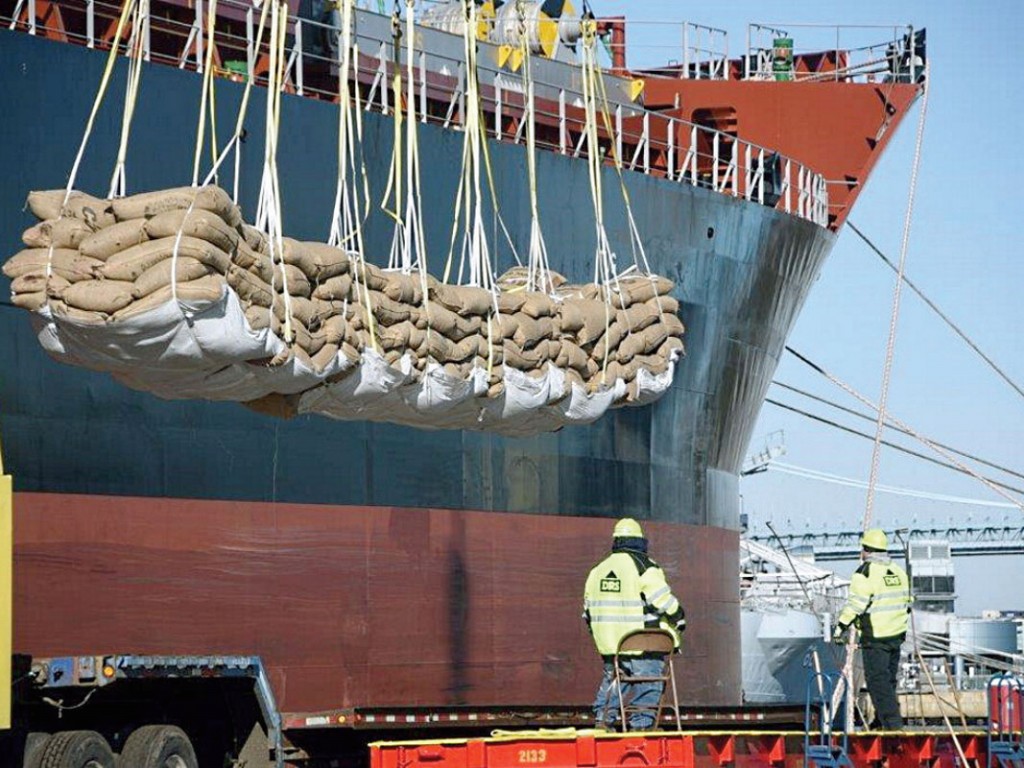Facilities are poised for 2021 breakbulk spikes
Interruptions in international trade thanks to Trump administration policies and the ravages of the COVID-19 pandemic took their toll on the volumes of some commodities handled at the facilities of South Jersey Port Corporation in 2020. But indications point to a nice rebound this year. There have also been swift movements in the development of the wind energy industry in southern New Jersey which will rebound to the benefit of local ports.
Cement tonnage dipped by 5% last year and gypsum by 30%, while wood products saw an increase of 35% in 2020. Cocoa beans was another commodity that did not suffer during 2020 at SJPC, actually more than tripling to 55,803 tons, as compared to the 17,452 tons handled in 2019. Last year’s cocoa numbers received a boost toward the end of the year when 215,000 150-pound sacks of beans were off-loaded from the ship Four Diamonds at the Joseph A. Balzano Marine Terminal in Camden, a facility operated by the SJPC.
Arriving on December 16, the cargo aboard the Four Diamonds meant that the annual flow of cocoa beans from West Africa began a month earlier than usual, pointing the way for another healthy year in 2021. The West African import season will run through April, to be followed by several months of imports of cocoa beans from Central American growers.
The tonnage handled in 2020 made Camden “the premier cocoa bean import terminal on the East Coast,” according to Andy Saporito, CEO and executive director of SJPC. The beans off-loaded in Camden head for final processing at regionally-based confectionary companies such as Hershey and Blommer, which are headquartered in Pennsylvania, and Mars, which is based in New Jersey.

The breakbulk beans handled at the South Jersey port make the logistics process “far more efficient than containerized beans,” said Jeff Wheeler, president of the Camden International Commodity Terminal. “We eliminate that additional step of loading and unloading millions of bags of beans from containers, both here and at the source.
“Cocoa bean inventories in the U.S. are comparatively low and need to be replenished,” Wheeler added. “As consumption ticks up, so will the need for more imports.”
Offshore Wind Offers Boost
Developments involving the offshore wind industry in southern New Jersey are moving rapidly. Only a few months after Governor Phil Murphy announced a plan in June 2020 to build a wind port on an artificial island in the Delaware River, came another announcement in December heralding a $250 million investment in a wind-related manufacturing facility in the Port of Paulsboro to be operated by EEW Group, a company based in Erndtebrück, Germany.
EEW has been in the business of producing steel pipe constructions and components for over 80 years. Its EEW Special Pipe Constructions subsidiary, based in the Rostock Port on the Baltic Sea, manufactures foundation structures for the offshore wind and oil and gas industries. EEW is already part of the supply chains for the first two U.S. offshore wind projects, noted Christoph Schorge, EEW’s CEO, as the company has delivered two 900-ton, 25-foot monopiles and other components for the Coastal Virginia Offshore Wind (CVOW) demonstration project as well as the pipes for the jacket foundations at the Block Island Wind Farm offshore Rhode Island, both being developed by Ørsted, the Danish wind energy company. Monopiles are part of the foundation of offshore wind installations that are driven into the seabed with large hydraulic hammers.
Paulsboro Marine Terminal is a 190-acre facility inaugurated in 2017, primarily to beef up South Jersey’s breakbulk capabilities. “Initially, 70 acres will be leased to EEW for monopile manufacturing,” said Brendan Dugan, assistant executive director and director of business development at the South Jersey Port Corporation.
Ørsted is also the concern that will be developing the Ocean Wind generation project offshore Atlantic City, N.J. In July 2019, EEW signed a memorandum of understanding with Ørsted towards establishing the monopile fabrication facility in Paulsboro that is now coming to fruition. The Paulsboro facility, in addition to building monopiles for Ocean Wind, will likely also serve other offshore wind sites around the United States, as specified in the MOU.
The monopile facility will represent the largest industrial offshore wind investment in the United States to date, according to the New Jersey governor’s office. Construction on the facility will break ground in January 2021, with production beginning in 2023.
“EEW will bring forward a factory capable of producing the world’s largest foundations required to support the ever-increasing wind turbines of the future,” said Schorge.
The EEW plant also “creates exciting potential to support hundreds of new jobs in the wind energy logistics business,” said Tom Holt Jr., principal of the Holt Logistics real estate arm that serves as landlord of the Paulsboro terminal.
The wind energy marshalling port proposed by New Jersey’s governor, which will be designed to assemble wind components for transport to offshore sites, will cost between $300 million and $400 million to fully develop, according to government estimates. Construction is planned in two phases, with 55 acres to be developed beginning in mid-2021, while another 150 acres will accommodate marshalling and manufacturing activities beginning in 2026.

Mid-Atlantic Marine Highway Project
In other developments, the US Maritime Administration (MARAD), an agency of the U.S. Department of Transportation, approved the designation of SJPC’s Camden facility as part of its Mid-Atlantic Marine Highway project. “This is the route currently served by the weekly Columbia Coastal container barge from Norfolk to Baltimore to Philadelphia,” said Dugan. “Camden’s inclusion in the project designation makes us eligible for grant funding for any infrastructure or handling equipment that could benefit the service.” Columbia Coastal added Philadelphia to its Norfolk-Baltimore route with weekly service in 2012.
“The barge is not yet calling on Camden,” Dugan noted, “but there is a lot of interest among importers and exporters who currently use Camden for breakbulk shipments, so we are working to make this a commercial reality.”




